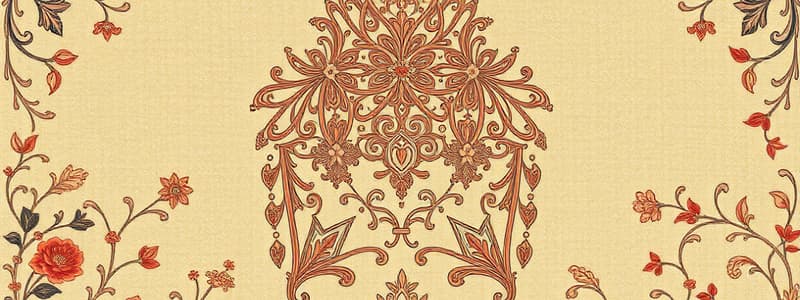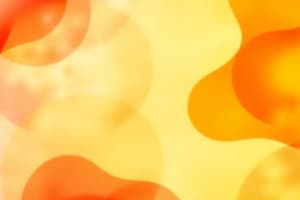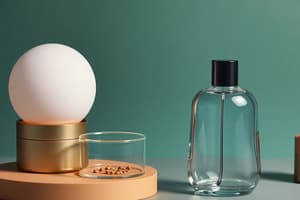Podcast
Questions and Answers
Which type of form is characterized by being inspired by nature and having irregular qualities?
Which type of form is characterized by being inspired by nature and having irregular qualities?
- Organic Forms (correct)
- Abstract Forms
- Symbolic Forms
- Geometric Forms
Which technique is commonly used to create the illusion of depth in a two-dimensional work of art?
Which technique is commonly used to create the illusion of depth in a two-dimensional work of art?
- Foreshortening (correct)
- Color Theory
- Texture Variations
- Line Weight
What are geometric forms commonly associated with?
What are geometric forms commonly associated with?
- Natural Beauty
- Order and Precision (correct)
- Emotional Expression
- Cultural References
Which form represents ideas or cultural references without depicting specific objects?
Which form represents ideas or cultural references without depicting specific objects?
What is the primary focus of abstract forms in art?
What is the primary focus of abstract forms in art?
Which form is characterized by having length and width but no depth?
Which form is characterized by having length and width but no depth?
Which of the following would NOT be considered a characteristic of Abstract Forms?
Which of the following would NOT be considered a characteristic of Abstract Forms?
What is the primary purpose of using perspective in visual arts?
What is the primary purpose of using perspective in visual arts?
Which term best describes forms that occupy physical space and can be viewed from multiple angles?
Which term best describes forms that occupy physical space and can be viewed from multiple angles?
Which type of forms often communicate deeper meanings through symbolism or cultural significance?
Which type of forms often communicate deeper meanings through symbolism or cultural significance?
Flashcards
Geometric Forms
Geometric Forms
Shapes defined by mathematical properties, like cubes, spheres, and cylinders. They often create a sense of order and precision.
Abstract Forms
Abstract Forms
Simplified or distorted shapes, moving away from realism. They focus on emotions and ideas instead of objects.
Organic Forms
Organic Forms
Shapes inspired by nature, with irregular and fluid qualities.
Symbolic Forms
Symbolic Forms
Signup and view all the flashcards
Illusion of Depth
Illusion of Depth
Signup and view all the flashcards
2D Form
2D Form
Signup and view all the flashcards
3D Form
3D Form
Signup and view all the flashcards
Perspective
Perspective
Signup and view all the flashcards
Interplay of 2D and 3D Forms
Interplay of 2D and 3D Forms
Signup and view all the flashcards
Applying Space and Form in Artwork
Applying Space and Form in Artwork
Signup and view all the flashcards
Study Notes
Principles of Design
- Design is the foundation for creating visually compelling and impactful experiences.
- Principles of design are the core building blocks for creating aesthetically-driven and functionally-effective work.
Balance
- Symmetrical Balance: Creates a sense of order and stability by arranging elements in a mirrored or reflective pattern. Works well for formal, elegant designs.
- Asymmetrical Balance: Utilizes unequal or offset placement of elements to create visual interest and energy. Can make designs feel more dynamic and modern.
Contrast
- Color Contrast: Using opposing or complementary colors creates visual tension and draws the eye to key focal points.
- Scale Contrast: Combining elements of vastly different sizes highlights important information.
- Texture Contrast: Using smooth and rough, matte and shiny textures creates depth and interest.
Emphasis
- Focal Point: Emphasizing a specific element draws the viewer's attention and creates a clear hierarchy in the design.
- Framing: Using borders, spacing, and other compositional techniques to frame key content emphasizes its importance.
- Scale: Enlarging or making certain elements larger than others immediately highlights their significance.
Movement
- Directional Cues: Arrows, lines, and shapes create a sense of movement and flow through the design.
- Repetition: Repeating similar elements creates a rhythmic flow that guides the viewer's eye. Alternating different elements creates a dynamic rhythm.
- Overlapping Elements: Layering objects suggests depth and implies motion, drawing the viewer's gaze.
- Repetition of patterns and elements: Can create a rhythmic movement that guides the eye through the design.
Pattern
- Structured Patterns: Geometric use of repeating shapes, lines, and colors create a sense of order and regularity.
- Organic Patterns: Natural, irregular patterns inspired by the environment evoke a sense of fluidity and growth.
- Symbolic Patterns: Patterns composed of meaningful icons, logos, or illustrations convey specific ideas or brand identities.
Color
- Color temperature influences perception and mood in art.
- Warm Colors: Red, orange, yellow evoke feelings of energy and excitement.
- Cool Colors: Blue, green, purple evoke feelings of calmness and serenity.
- Color harmony refers to aesthetically pleasing arrangements of colors.
- Monochromatic: Uses variations (shades, tints, tones) of a single color.
- Complementary: Combines colors opposite each other on the color wheel (e.g., red and green).
- Analogous: Uses adjacent colors on the color wheel (e.g., blue, blue-green, green).
- Triadic: Uses three equally spaced colors (e.g., red, yellow, and blue).
- Color contrast impacts the visual effect
- High Contrast: Opposite colors on the color wheel (e.g., red and green) create energy.
- Low Contrast: Similar colors create harmony and subtlety
Texture
- Texture refers to the surface quality of an artwork.
- Actual: Physical surface qualities (roughness or smoothness.)
- Implied: Illusions of texture created using artistic techniques (light, shadow, line work)
- Combined: Actual and implied combined for richness.
Space and Form
- Space: The area within or around a work of art. Can be 3D or 2D, and how an artist uses and manipulates space affects the overall composition, depth, and balance of a work of art.
- Form: The three-dimensional quality, the physical manifestation, including outward appearance and internal structure and volume.
- Perspective: Technique used to create the illusion of depth and three dimensional space. Perspective helps artists direct the viewer's attention.
Studying That Suits You
Use AI to generate personalized quizzes and flashcards to suit your learning preferences.




